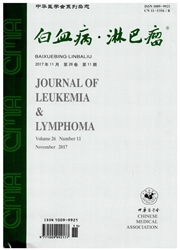

 中文摘要:
中文摘要:
目的探讨急性早幼粒细胞白血病(APL)患者融合基因特点与其疗效、预后及生存的关系。方法采用荧光定量聚合酶链反应(PCR)的方法对41例形态学初诊为APL患者进行PML—RARd、PLZF.RARd融合基因动态监测,比较不同类型融合基因患者达到完全分子生物学缓解(CMR)的时间及患者的生存率、生存时间。结果41例初诊APL患者,PML—RARd.L型阳性29例,中位年龄43岁(8—75岁),基因表达水平(60.12±41.24)%,白细胞中位值2.1×109/L(0.44×109/L~124×109/L);PML-RARoL—S阳性ll例,中位年龄34岁(19~66岁),基因表达水平(24.36±25.72)%,自细胞中位值3.2×109/L(0.47×109/L-88×109/L);PML—PLZF1例,基因表达水平较高(64.12%)。患者达到完全分子生物学缓解中位时间L型40d(32~60d)。S型56d(25~86d);随访5年无事件生存率分别为100.0%和81.8%(P=0.02);1例PML.PLZF阳性患者18个月内未达到CMR,且存在C—KIT基因突变,形态学复发2次。结论融合基因PML—RARd—L型APL患者疗效、预后及无事件生存率均好于S型患者,PLZF—RAR0【基因融合的APL患者易复发且预后较差;APL融合基因分型及预后突变基因的检测,对患者的疗效判定及预后有着非常重要的意义。
 英文摘要:
英文摘要:
Objective To investigate the relationship of fusion gene characteristics and therapeutic efficacy, prognosis, survival in patients with acute promyelocytic leukemia (APL). Methods dynamicly PML-RARct and PLZF-RARct of 41 newly diagnosed APL patients were monitored with Q-PCR and analyzed. According to patients" fusion gene types, the time reaching complete molecular remission, the patients" survival time and rate were compared and analyzed. Results 29 of 41 newly diagnosed APL patients were observed PML-RARa-L positive, with a median age of 43 years old (8-75 years old), gene expression levels of (60.12±41.24) %, and leukocyte median value of 2.1×109/L [(0.44-124)×109/L]. 11 of 41 cases were observed PML-RARct-S positive, with a median age of 34 years old (19-66 years old), gene expression levels of (24.36±25.72) %, and leukocyte median value of 3.2×109/L [(0.47-88)×109/L], for just one patient, the gene expression level of PML-PLZF was 64.12 %. The median time reaching complete molecular remission were 40 days (32-60 days) for L-type patients, and 56 days (25-86 days) for S-type patients, the event-free survival rate by 5-year follow-up were 100 % and 81.8 % for L-type and S-type, respectively (P -- 0.02). The PLZF-RARoL-positive patient with C-KIT mutation didn" t have complete molecular remission, morphological relapse occurred two times within 18 months. Conclusions For APL patients with PML-RARa-L, the therapeutic effect, prognosis, and event-free survival rate are better than APL patients with PML-RARa-S. APL patients with PLZF-RARct are prone to higher relapse and poor prognosis. It" s of high significance to evaluate the therapeutic efficacy and prognosis by detecting fusion gene and possible gene mutations for APL patients.
 同期刊论文项目
同期刊论文项目
 同项目期刊论文
同项目期刊论文
 期刊信息
期刊信息
